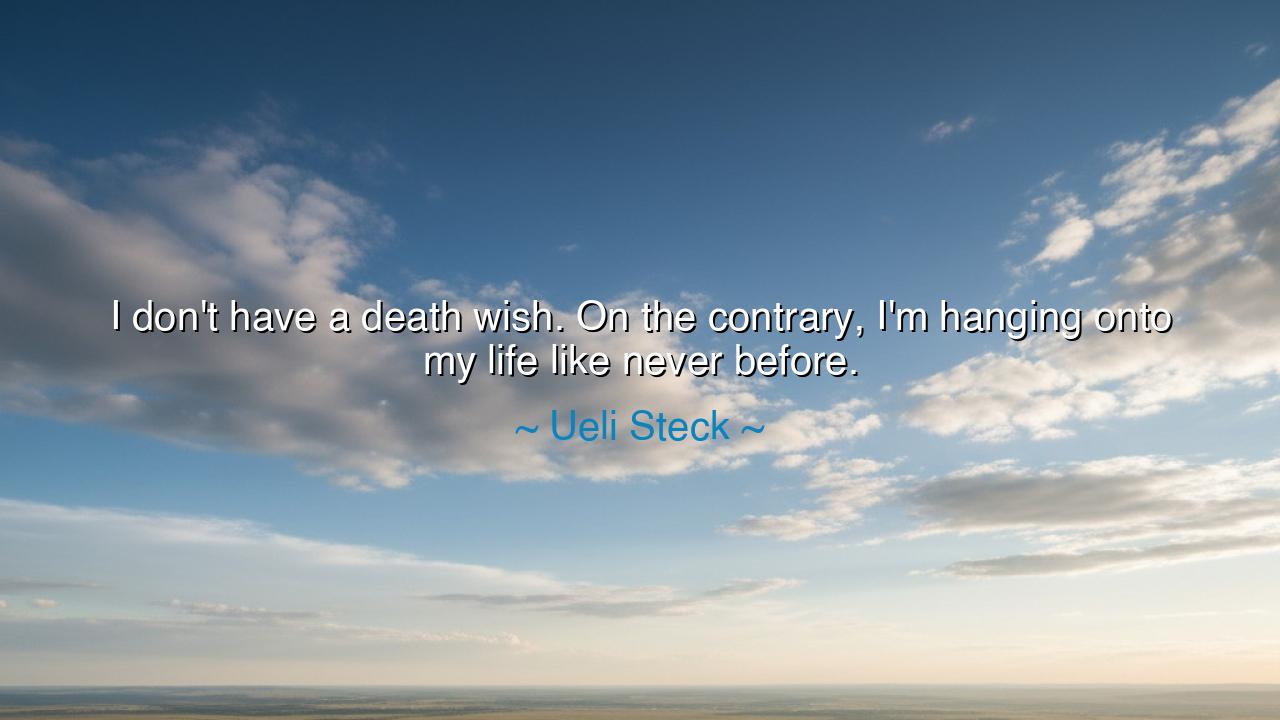
I don't have a death wish. On the contrary, I'm hanging onto my
I don't have a death wish. On the contrary, I'm hanging onto my life like never before.






The words of Ueli Steck — “I don’t have a death wish. On the contrary, I’m hanging onto my life like never before.” — are not the boast of a reckless man, but the confession of a soul who has looked into the face of danger and chosen life with greater intensity than most will ever know. They come from a mountaineer who danced along the thin line between survival and oblivion — one of the greatest climbers of his generation, who moved across ice and stone as if he were born from the mountain itself. In these words, Steck reveals a truth that has echoed through the hearts of all who live on the edge of possibility: that to embrace risk is not to seek death, but to celebrate life. For only those who have stood where breath and silence meet understand how precious existence truly is.
To understand the weight of these words, one must understand the man who spoke them. Ueli Steck, the “Swiss Machine,” was a climber of astonishing speed and precision, known for solo ascents up the most perilous faces of the Alps and the Himalayas. His feats seemed superhuman — running up the north face of the Eiger in under three hours, ascending mountains that had defeated others for decades. Many looked upon his exploits and saw madness, a death wish, a hunger for destruction disguised as glory. But Steck himself denied this. What drove him was not the lure of death, but the purity of focus that comes when one confronts it. For in that place — where one misstep could end all — there is no room for illusion, only the truth of being alive.
In saying that he hangs onto life “like never before,” Steck speaks to the paradox of those who live closest to danger: that they feel the pulse of life more vividly than those who hide from it. The climber who ascends the vertical ice wall, the sailor who faces the storm, the soldier who charges into battle — all of them know that death’s nearness does not diminish life; it sharpens it. For when everything fragile can be taken away in a heartbeat, every breath becomes sacred, every heartbeat a gift. This is not recklessness — it is reverence. It is to say, “I am alive, and I know it,” with every fiber of one’s being.
The ancients understood this truth well. The Stoic philosophers of Greece and Rome — Seneca, Marcus Aurelius, and Epictetus — taught that to live well, one must live with death in sight. They did not glorify death, but accepted its presence as the teacher of wisdom. “Think of yourself as dead,” wrote Marcus Aurelius, “you have lived your life. Now take what’s left and live it properly.” Steck’s life was an embodiment of this philosophy, though expressed in the language of movement and mountain, not parchment and pen. His climbs were meditations — acts of mindful defiance — where he met fear, not with denial, but with discipline. His mastery was not in escaping risk, but in transforming it into art.
In history, many have found their purpose in this dance with mortality. Consider Amelia Earhart, who crossed oceans in fragile machines of fabric and metal, defying both gravity and convention. When asked if she feared death, she answered, “Adventure is worthwhile in itself.” Like Steck, she did not chase death — she embraced life so fiercely that safety alone could not contain her spirit. Both remind us that the goal is not to seek peril, but to live so intensely that fear no longer rules us. To “hang onto life” as they did is to live fully — not half awake in comfort, but alive in the full storm of existence.
Yet Steck’s quote carries another layer of meaning: the humility of the mortal who knows his limits. To hang onto life “like never before” is also to recognize its fragility. It is not arrogance that speaks, but awe. Those who walk the knife-edge between triumph and tragedy learn to respect the thinness of that line. Steck’s own life ended, fittingly, on a mountain — the Nuptse face of Everest in 2017 — not as a man who sought death, but as one who sought to understand life in its purest form. His fall was not a failure, but the completion of his journey. The mountain did not claim him; it received him.
The lesson of his words is one of courageous awareness. We do not need to climb mountains to live as he did. Each of us has our own precipice — a challenge, a calling, a fear to confront. The key is not to run from it, nor to throw oneself blindly into it, but to face it with purpose, with reverence, and with full consciousness of the stakes. To live as Steck lived is to look death in the eye and say, “I am not ready to die because I have only begun to live.” It is to honor the fragile gift of life by using it completely — by daring, striving, loving, and creating without restraint.
So remember the spirit behind Ueli Steck’s words: that life is not measured by safety, but by intensity of living. Do not seek to escape fear, but to walk beside it. Do not wait for perfect security before acting — for security is an illusion, and time is brief. Instead, climb your own mountain, whatever it may be, and hang onto life with both hands and an open heart. For to live in such a way — aware of mortality, yet unafraid of it — is to be, as Steck was, truly and magnificently alive.






AAdministratorAdministrator
Welcome, honored guests. Please leave a comment, we will respond soon